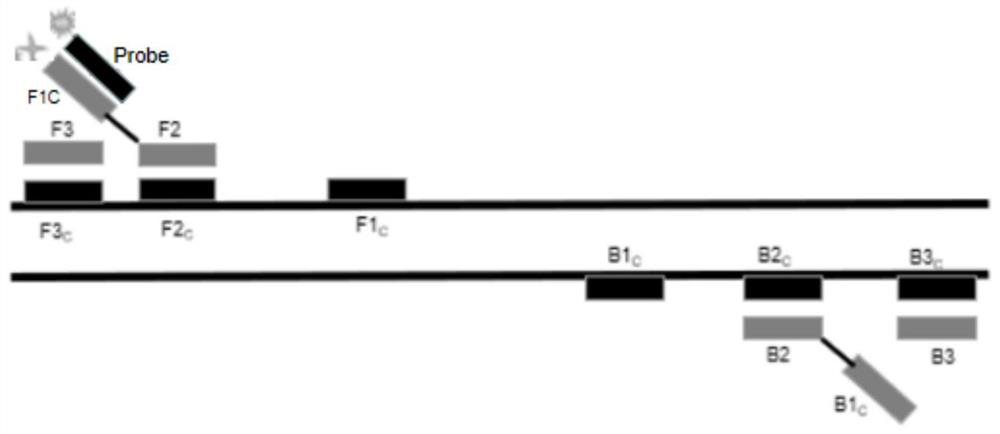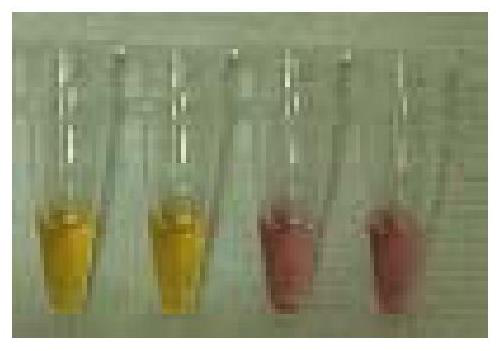LAMP (loop-mediated isothermal amplification) double-strand detection probe and freeze-dried microsphere for burkholderia gladioli as well as preparation method and detection method of freeze-dried microsphere
A Holderella and detection probe technology, applied in the field of LAMP double-stranded detection probes for Burkholderia gladiolus, can solve the problem of low specificity and false positives, aerosol pollution, strong subjective factors, etc. problem, to achieve the effect of high accuracy, avoiding pollution, and not easy to false positive
- Summary
- Abstract
- Description
- Claims
- Application Information
AI Technical Summary
Problems solved by technology
Method used
Image
Examples
Embodiment 1
[0045] Example 1 LAMP double-stranded detection probe and primer design
[0046]The conserved sequences of Burkholderia gladiolus were screened out through literature review and comparison, and the primers and probes of the target sequences were designed using special LAMP primer design software, and the designed primers and probes were designed on Primer-blast. Analysis and optimization, primer and probe design principles and positions such as figure 1 As shown, the finalized probe and primer sequences are as follows:
[0047] The probe consists of two parts, one is a luminescent probe and the other is a quenching probe. The 5' end of the luminescent probe is labeled with a fluorescent light-emitting group, such as FAM, VIC, TET, etc. The 3' end of the quenching probe is labeled with Quenching light groups such as TAMRA, QSY, BHQ, etc., the luminescent probe is located on FIP, the fluorophore is labeled at the 5' end of FIP, the quenching probe is complementary to the F1C se...
Embodiment 2
[0053] The present embodiment provides a freeze-dried microsphere for detecting Burkholderia gladiolus, and its preparation method includes:
[0054] (1) Preparation of lyoprotectant: 70% trehalose, 8% glycine, and 25% PEG20000 were mixed in a volume ratio of 2:3:6 to obtain a lyoprotectant.
[0055] (2) Construct an amplification reaction system:
[0056] The total volume of the LAMP detection and amplification system constructed in this example is 15 μL, and the detection primer set shown in Table 1 is mixed with the LAMP reaction base liquid shown in Table 1 to obtain an amplification reaction system.
[0057] Table 1. Amplification reaction system
[0058] component name Concentration (μM) Addition amount (μL) Outer primer F3 / B3 100μM 0.05-0.1 Internal primer FIP / BIP 100μM 0.4-0.5 double-stranded detection probe 100μM 0.1-0.2 Bst DNA polymerase 8U 1-1.5 dNTPs 10mM each 3.0-4.0 betaine 5M 3-5 Reagent 200mM ...
Embodiment 3
[0061] Example 3 Establishment of LAMP detection reaction system
[0062] The total volume of the LAMP detection reaction system constructed in this example is 25 μL, which specifically includes:
[0063] The freeze-dried microspheres prepared in Example 2 were added to 26 μL of water for reconstitution, and the template DNA (2 μL) extracted from the sample to be tested was added to the reconstituted reaction system, and the reaction was carried out at 60 to 65 ° C for 50 to 70 min, LAMP amplification was performed; in this example, the amplification was performed at 63° C. for 60 min.
[0064] Result judgment:
[0065] (1) Visual method, directly observe the color change, so as to determine the LAMP amplification and the presence or absence of Burkholderia gladiolus in the sample.
[0066] (2) Fluorescence curve method, the fluorescence quantitative PCR instrument is used to collect the fluorescence of the luminescent group, and the amplification curve is given to judge the...
PUM
 Login to View More
Login to View More Abstract
Description
Claims
Application Information
 Login to View More
Login to View More - R&D
- Intellectual Property
- Life Sciences
- Materials
- Tech Scout
- Unparalleled Data Quality
- Higher Quality Content
- 60% Fewer Hallucinations
Browse by: Latest US Patents, China's latest patents, Technical Efficacy Thesaurus, Application Domain, Technology Topic, Popular Technical Reports.
© 2025 PatSnap. All rights reserved.Legal|Privacy policy|Modern Slavery Act Transparency Statement|Sitemap|About US| Contact US: help@patsnap.com



